Ram Navami, also known as Shri Ram Janmotsav, is celebrated with great enthusiasm by Hindus to commemorate the birth of Lord Ram in the Treta Yuga on this earth planet.
Following the Hindu Lunar Calendar, Ram Navami is celebrated in the Chaitra month, specifically on the ninth day of the Shukla Paksha. Ram Navami usually falls in March or April. This year, Ram Navami is being celebrated on April 17th, 2024.
Original account of Ram Janm from the Epic Ramayana
Ram Navami marks the day when Lord Ram took avatar in Ayodhya as the son of King Dashrath and Mother Kaushalya.
As per the Valmiki Ramayana, King Dasharatha did not have any heir. When encouraged by his Guru Vashishtha, King Dashrath and his three wives, Kaushalya, Kaikeyi, and Sumithra performed a Yagya (fire sacrifice) beseeching the gods to bless them with children. Upon successful completion of the Yagya, four heirs were born in the dynasty of King Dashrath on the auspicious Ram Navami Day - Queen Kaushalya gave birth to Rama, Sumitra gave birth to Lord Shatrughan and Lord Lakshaman, and Kaikeyi gave birth to Bharat.
Read heart touching Leela of Ram Janma and how the all mighty Lord Vishnu becomes Baby Ram to fulfill Queen Kaushalya’s wish.
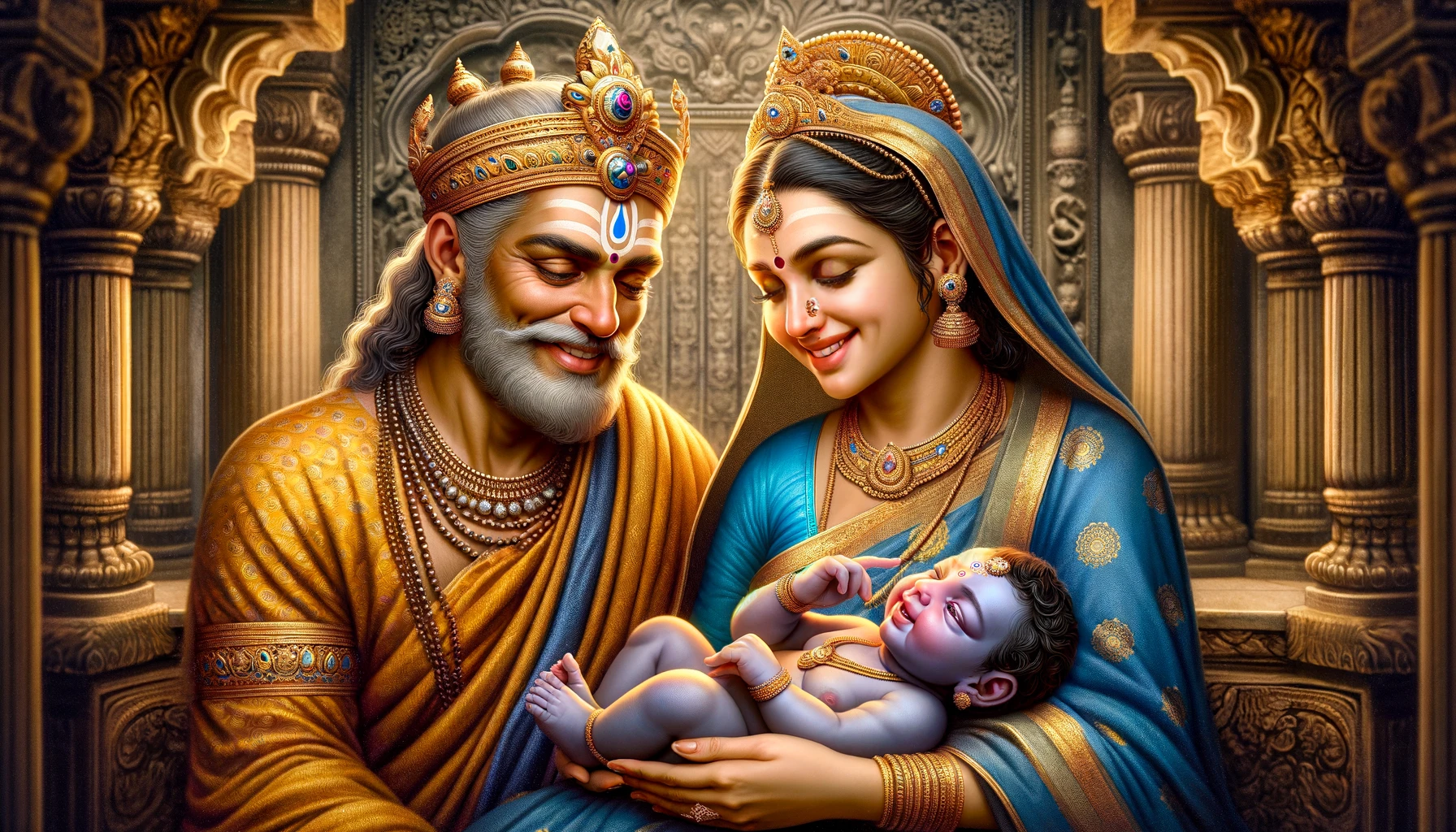
Who is Ram? Literal meaning of the word Ram?
Let’s hear from Swami Mukundananda the meaning of the word Ram –
“Ra means the Universe and Ma means the master. We all know there is one creator, who is all powerful, omniscient, all pervading and sitting in the hearts of all living beings. And yet, many ages ago, an event happened, that completely transformed the landscape of Bhakti forever. The Father of all living beings, descended on this planet as the son of Dashrath and Kaushalya.”
Watch Swami ji explaining the meaning of 'Rama' at the Dallas Diwali Mela.
Swami Mukundananda explaining the meaning of Ram
What was the purpose of Ram Janm (avatar)?
According to the sages, the Vedas and the Puranas, whenever righteousness decreases and the unrighteous increase, Vishnu assumes an earthly form (avatar) to defeat the wicked and protect his devotees.
Ravana, a powerful demonic king in Lanka, was born with ten heads and underwent intense austerities to please Lord Brahma. Brahma granted him the power to assume any physical form and restore his heads. Ravana became arrogant, unlawful, and adharmic, becoming an incurable war monger. He attacked and conquered many celestial Gods, rulers in higher worlds, earth, and the nether world, killing many saints and sages. He was also a womanizer, capturing beautiful women from all worlds for his enjoyment. When the celestial Gods, along with Lord Brahma, could no longer bear Ravana's onslaught, they met Lord Vishnu, the Lord of protection, and he promised to take birth as King Dasharath's son to annihilate Ravana.
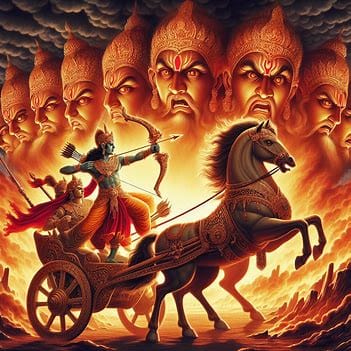
The principal aim of Rama Avatar was to destroy the wicked Asura (demonic) ruler Ravana and his allies. However, Lord Rama lived such an exemplary life as a young man, a prince, a loving husband married to a single woman, a devoted son, a loving brother, a humble and spiritually evolved human being, a great and powerful warrior, a great king, and a non-compromising follower of dharma, that he set countless examples of righteous living throughout his life for people to follow.
The significant role of Ram in shaping India’s society, culture, and politics.
Lord Rama is worshiped as an epitome of an ideal man. Lord Rama who is an ideal in every regard of a perfect son, an ideal brother, a wonderful husband, a mighty king and a great father, is not simply a hero but also someone who is the true representative of a flawless human being.
Ram's leadership qualities are widely recognized, positioning him as the ultimate role model for kingship. The Indian political and social systems have been significantly shaped by his principles of justice, equality, and compassion.
Even in the present, his life and teachings are extensively analyzed to gain insight into the attributes of a perfect leader.
Lord Ram is regarded as the symbol of righteousness and guardian of Dharma, the ethical code. The influence of his adherence to Dharma has spanned generations, inspiring Hindus to embrace his teachings and lead lives filled with integrity and moral uprightness.
Ram and his extended family have also contributed to the understanding of how to foster and sustain healthy family relationships, which in turn contributes to a joyful and tranquil family life, serving as a solid foundation for the success of future generations. Read this blog: Fascinating stories from Ramayana.
Ram's values of respect, love, and duty towards his family have been embedded in the Indian culture, and the importance of family and relationships is still a significant part of Indian traditions.
How is Ram Navami celebrated?
People celebrate Ram Navami by chanting the divine names, conducting poojas and other rituals based on the region of the country. But the celebration of the birth of Lord Ram is always a joyous occasion regardless of the part of the country or world where people of Indian descent reside!
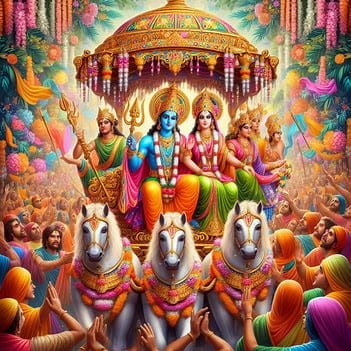
Celebrating Ram Navami at Home
Ram Navami at home is a celebration of devotion, family bonding, and righteousness and purity.
It involves creating a sacred space, decorating the home with colorful torans and Rangoli designs, and preparing for the puja. A designated area is transformed into a space with idols of Lord Rama, Sita, Lakshmana, and Hanuman placed on a platform. Offerings such as fruits, flowers, sweets, and incense are arranged near the idols. Puja materials like thali, diya, gangajal, and roli are readied.
The puja ceremony includes prayers, mantras, offerings, bhajans, and kirtans, reciting sacred chants and songs. After the puja, those who fast can enjoy a simple vegetarian meal. Family time and sharing include reading stories from the Ramayana epic and sharing prasadam with neighbors. Regional variations include cradle ceremonies in North India and drama and performances in South India.
Celebrating Ram Navami as a Community
The grandeur and splendor of Ram Navami celebrations can be witnessed on a massive scale in every corner of India and around the world. The spirit of Ram Navami transcends borders, uniting Hindus worldwide in their reverence for their ideal king and embodiment of righteousness.
Devotional Gatherings:
- Temples: The heart of the celebrations lies in temples dedicated to Lord Rama or Vishnu. Hindus gather for special pujas, prayers, and recitation of Ramayana verses. The atmosphere is filled with chants, hymns, and devotional songs (bhajans and kirtans).
- Community Halls: In some areas, community halls might host special events like discourses on the Ramayana, bhajans, and kirtans, allowing people to come together and celebrate their faith.
Festive Spirit:
- Processions (Rath Yatras): Elaborate processions, known as Rath Yatras, are a spectacular feature in some regions. Large chariots carrying idols of Lord Rama, Sita, Lakshmana, and Hanuman are drawn through the streets, accompanied by music and dance. Devotees throng the streets, chanting and showering flowers on the chariots.
- Street Decorations: Streets and public spaces are often decorated with colorful flags, buntings, and banana leaves. Houses might also be adorned with lights and rangolis, creating a festive ambiance.
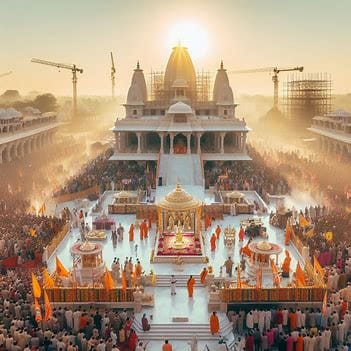
Charitable Acts:
- Food Distribution (Langar): Langars, community kitchens, serve free vegetarian meals to all visitors, especially the underprivileged. This embodies the spirit of seva (service) and reinforces the importance of sharing and social responsibility.
- Donations: Charitable donations might be offered to temples or organizations assisting the needy.
Cultural Performances:
- Ramlila Enactments: Dramatic enactments of the Ramayana story, known as Ramlila, are popular in many regions. These open-air performances can last for several days, with actors portraying characters from the epic and bringing the story to life.
- Folk Dances and Music: Traditional folk dances and music specific to different regions might be performed, adding a vibrant cultural dimension to the celebrations.
- Folk Dances in South India: Community halls or temples might host cultural programs featuring dance performances like Bharatanatyam or Kuchipudi, depicting stories from the Ramayana.
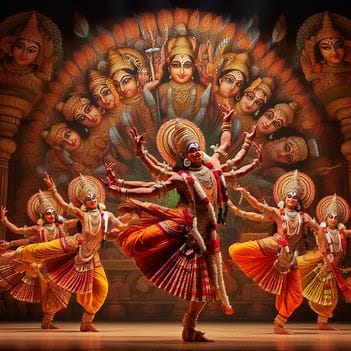
Regional Variations:
- Ayodhya, the birthplace of Lord Rama, witnesses grand celebrations with massive processions, elaborate decorations, and cultural programs.
- South India: In some parts of South India, a unique tradition involves coating oneself with turmeric paste, symbolizing purification and renewal.
The celebration of Ram Navami goes beyond religious barriers. It promotes social unity, cultural interchange, and provides a chance to contemplate the enduring values and high ideals represented by Lord Rama.
What are some of the traditional Ram Navami foods?
Traditionally, many Hindus observe a fast on this day, with specific dietary restrictions. Here's a breakdown of the food aspects of Ram Navami:
Fasting Foods:
- Sattvic Foods: During the fast, people typically consume Sattvic foods, which are considered pure and promote peace and spiritual well-being. These might include:
- Fruits: A variety of fresh fruits like apples, bananas, mangoes, and oranges are popular choices.
- Dry Fruits: Dates, figs, raisins, and almonds are good options for a quick and nutritious energy boost.
- Sabudana Khichdi: A light and healthy dish made with tapioca pearls (sabudana), potatoes, peanuts, and spices.
- Singhara ki Poori: A puffed flatbread made with water chestnut flour, often served with a potato or lentil filling.
- Kuttu ki Poori: Similar to Singhara poori, but made with buckwheat flour.
- Curd (Dahi): A cooling and refreshing element in the fasting diet. It can be consumed plain or with chopped fruits and nuts.
Sweet Offerings (Prasadam):
- After the puja (worship) rituals, there's a tradition of offering sweet dishes as prasadam (offerings to the deity). Some popular choices include:
- Seviyan Kheer: A sweet pudding made with vermicelli, milk, sugar, and nuts.
- Panjiri: A sweet and nutty energy bar made with ghee, flour, and nuts.
- Halwa: There are many varieties of halwa, a dense and rich pudding made with semolina, flour, vegetables, or fruits.
- Puran Poli: A flatbread stuffed with a sweet lentil filling.
- Coconut Ladoo: A sweet ball made with coconut, sugar, and ghee.
Regional Variations:
- The specific fasting foods and prasadam offerings can vary depending on the region and family traditions.
- In South India, for example, dishes like bellada hannina panaka (jaggery juice), mung dal-carrot salad, and gojjavalakki (spicy poha) might be included.
Ram Navami 2024 FAQs
Q. When is Ram Navami being celebrated in 2024?
According to Hindu Lunar Calendar, Ram Navami is being celebrated on April 17th, 2024.
Q. Why should I celebrate Ram Navami with my community?
Celebrating Ram Navami together allows families to share their faith and participate in traditions that have been passed down for generations. By observing rituals, prayers, and stories of Ramayana, children learn about Lord Ram's ideals of righteousness, courage, and devotion. This can be a valuable way to instill moral compass and positive values in the next generation. Celebrating cultural festivals like Ram Navami strengthens a community's connection to their heritage and traditions. This can be especially important for families living away from their cultural roots.
Ram Navami will be celebrated in the divine presence of Swami Mukundanada at the JKYog US Head Quarters - Radha Krishna Temple of Dallas. We highly encourage you to attend with friends and family. See program details here.
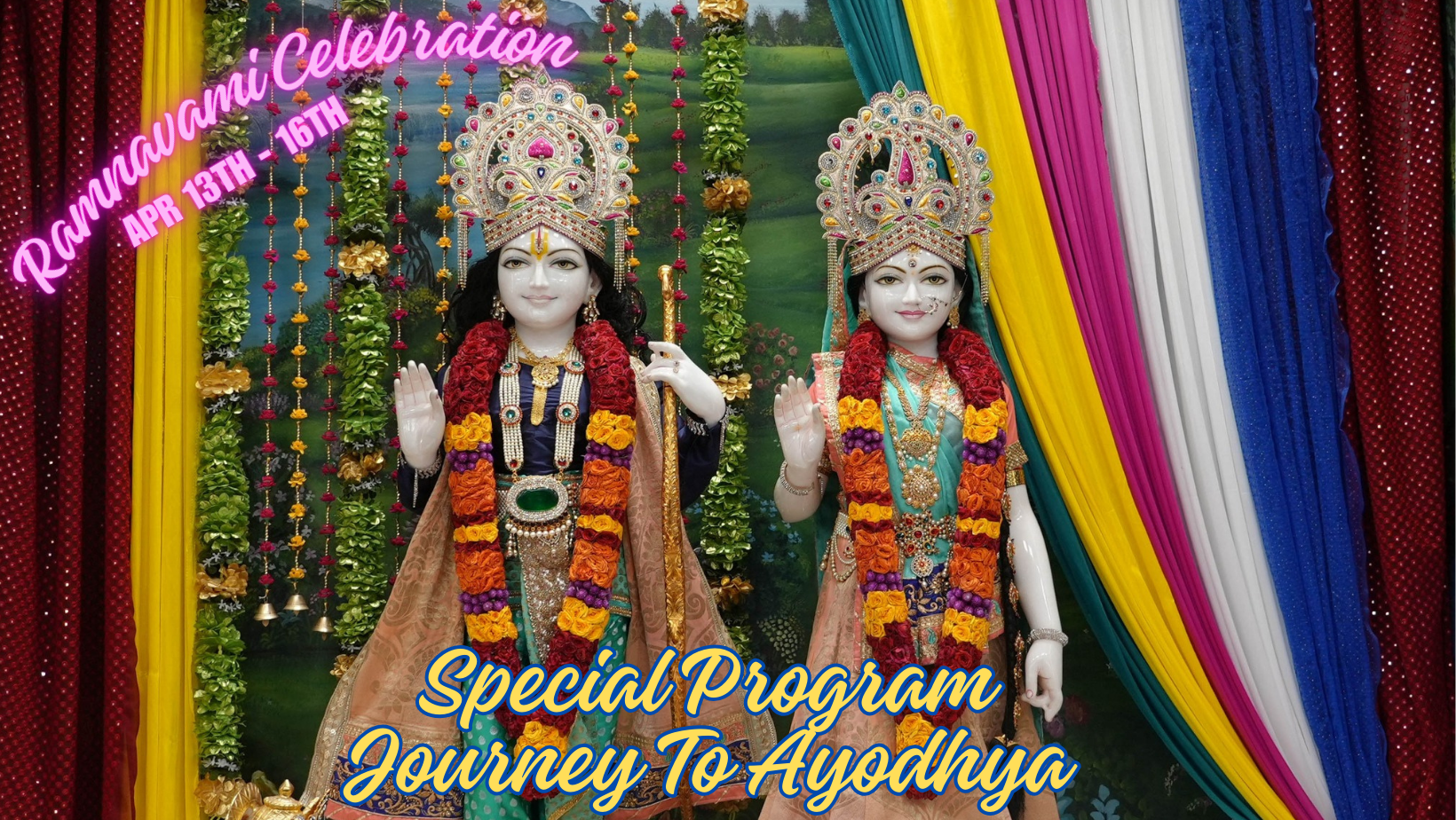
Q. How do I celebrate Ram Navami at home?
Here are some guidelines. Some or all of these can be followed based on your personal situation and interest.
Create a Sacred Space:
- Cleaning: The home is thoroughly cleaned to create a pure and welcoming environment for the divine presence.
- Decoration: The entrance is adorned with a colorful toran (doorway hanging) made of mango leaves or marigolds. Rangoli designs, intricate patterns made with colored powders, are drawn at the entrance and in the puja area.
Prepare for the Puja:
- Altar Setup: A designated area is transformed into a puja space. Pictures or idols of Lord Rama, Sita, Lakshmana, and Hanuman are placed on a platform.
- Offerings: Fruits, flowers, sweets (like those mentioned previously), and incense are arranged near the idols. Puja materials like a puja thali (plate), diya (lamp), gangajal (holy water), and roli (red powder) are readied.
The Puja Ceremony:
- Prayers and Mantras: Family members gather for the puja. Mantras (sacred chants) dedicated to Lord Rama are recited. Hanuman Chalisa can also be recited. Find Hanuman Chalisa verses in English with meanings here.
- Aarti: A lighted lamp is offered to the deities, signifying reverence and devotion. Here’s a Ram Arti sung by the devotees at the JKYog US Head Quarters – Radha Krishna Temple of Dallas.
- Bhajans and Kirtans: Devotional songs praising Lord Rama and the Ramayana story are sung, creating a spiritual atmosphere.
Popular Ram Bhajan by Swami Mukundananda -
Ram Bhajan by Swami Mukundananda
Breaking the Fast (if observed):
- After the puja, those who fasted can partake in a simple and vegetarian meal consisting of the prepared prasadam.
Family Time and Sharing:
- Stories and Ramayana Readings: The family might gather to read or listen to stories from the Ramayana epic, reflecting on Lord Rama's virtues and teachings.
- Sharing Prasadam: The prepared sweets and offerings are distributed among family members and shared with neighbors, fostering a sense of community and togetherness.
Links and Resources:
Swami Mukundananda, known for his emphasis on practical spirituality and character development, has spoken and written extensively about the Ramayana and Lord Rama and his pastimes with different characters.
He describes Lord Rama as the embodiment of ideal leadership, showcasing qualities like Righteousness and justice, Compassion and devotion, Courage and strength, Obedience and respect, Fidelity and loyalty.
Swami ji emphasizes how Ram's story offers valuable lessons for everyone and encourages all to apply Ram's principles to overcome personal challenge, develop inner strength and face difficulties with grace and most importantly to foster devotion and strengthen our connection with the divine.
Here are some resources related to Rama Janm and Ram's pastimes with His extended family that you might find helpful:
Swami Mukundananda YouTube Videos:
- When Lord Vishnu became Shree Ram - The Secret of Ram Avatar in Ramayana
- Surrender to Lord Ram that WILL Clear your Karma - Vibhishana Ramayana Story
- Lord Ram The Supreme God or Just a King of Ayodhya? Unheard Story of Ramayana l Swami Mukundananda
Swami Mukundananda Blogs:
- Ram Navami 2024 – Witnessing the Birth of Lord Ram
- The Spiritual Essence and Significance of the Ram Mandir: A Comprehensive Perspective
- Faith in the Divine: Lessons from Angad's Courageous Journey to Lanka
- How to Overcome Challenges in Life – Practical Lessons from Hanuman's Journey in Sunderkand
- What is True Love - fascinating stories from Ramayana
Swami Mukundananda Books:


